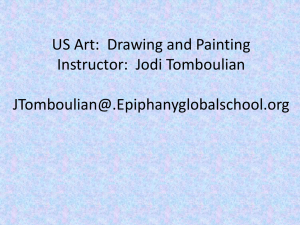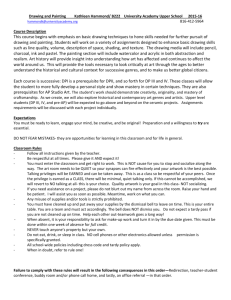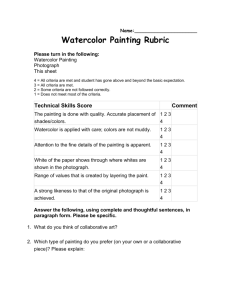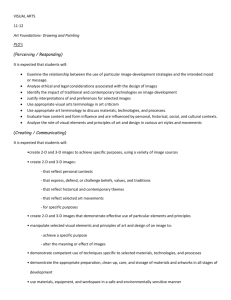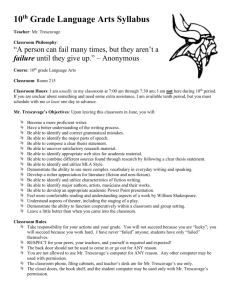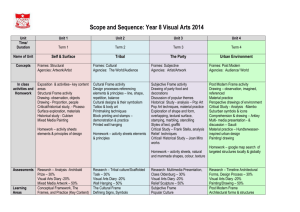Syllabus – Art Basic – Mr - Gonzaga College High School
advertisement
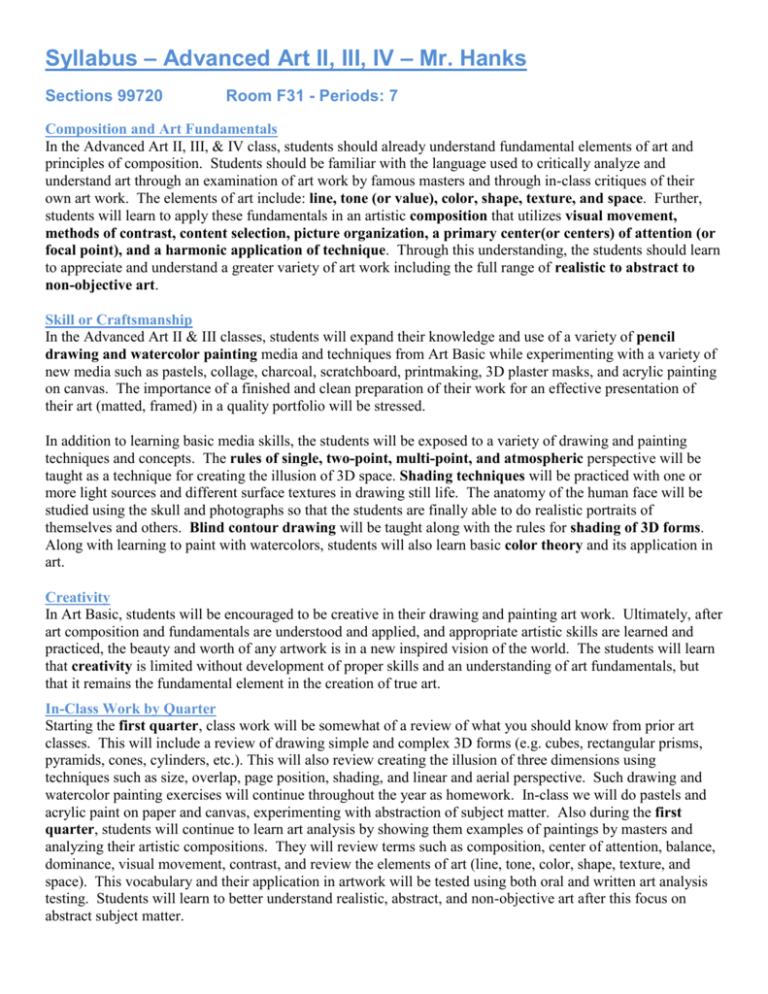
Syllabus – Advanced Art II, III, IV – Mr. Hanks Sections 99720 Room F31 - Periods: 7 Composition and Art Fundamentals In the Advanced Art II, III, & IV class, students should already understand fundamental elements of art and principles of composition. Students should be familiar with the language used to critically analyze and understand art through an examination of art work by famous masters and through in-class critiques of their own art work. The elements of art include: line, tone (or value), color, shape, texture, and space. Further, students will learn to apply these fundamentals in an artistic composition that utilizes visual movement, methods of contrast, content selection, picture organization, a primary center(or centers) of attention (or focal point), and a harmonic application of technique. Through this understanding, the students should learn to appreciate and understand a greater variety of art work including the full range of realistic to abstract to non-objective art. Skill or Craftsmanship In the Advanced Art II & III classes, students will expand their knowledge and use of a variety of pencil drawing and watercolor painting media and techniques from Art Basic while experimenting with a variety of new media such as pastels, collage, charcoal, scratchboard, printmaking, 3D plaster masks, and acrylic painting on canvas. The importance of a finished and clean preparation of their work for an effective presentation of their art (matted, framed) in a quality portfolio will be stressed. In addition to learning basic media skills, the students will be exposed to a variety of drawing and painting techniques and concepts. The rules of single, two-point, multi-point, and atmospheric perspective will be taught as a technique for creating the illusion of 3D space. Shading techniques will be practiced with one or more light sources and different surface textures in drawing still life. The anatomy of the human face will be studied using the skull and photographs so that the students are finally able to do realistic portraits of themselves and others. Blind contour drawing will be taught along with the rules for shading of 3D forms. Along with learning to paint with watercolors, students will also learn basic color theory and its application in art. Creativity In Art Basic, students will be encouraged to be creative in their drawing and painting art work. Ultimately, after art composition and fundamentals are understood and applied, and appropriate artistic skills are learned and practiced, the beauty and worth of any artwork is in a new inspired vision of the world. The students will learn that creativity is limited without development of proper skills and an understanding of art fundamentals, but that it remains the fundamental element in the creation of true art. In-Class Work by Quarter Starting the first quarter, class work will be somewhat of a review of what you should know from prior art classes. This will include a review of drawing simple and complex 3D forms (e.g. cubes, rectangular prisms, pyramids, cones, cylinders, etc.). This will also review creating the illusion of three dimensions using techniques such as size, overlap, page position, shading, and linear and aerial perspective. Such drawing and watercolor painting exercises will continue throughout the year as homework. In-class we will do pastels and acrylic paint on paper and canvas, experimenting with abstraction of subject matter. Also during the first quarter, students will continue to learn art analysis by showing them examples of paintings by masters and analyzing their artistic compositions. They will review terms such as composition, center of attention, balance, dominance, visual movement, contrast, and review the elements of art (line, tone, color, shape, texture, and space). This vocabulary and their application in artwork will be tested using both oral and written art analysis testing. Students will learn to better understand realistic, abstract, and non-objective art after this focus on abstract subject matter. In the second quarter, we will continue use of various drawing and painting media and the exploration of abstract subject matter. Students will do a complex abstract still life painting for the mid-term exam. More art appreciation and analysis will continue in the second quarter with more testing. Homework will include a mix of drawing and watercolor painting. In the third quarter, students will continue do some printmaking, and perhaps combine it with painting. As for content, we will focus on face and figure studies. More art appreciation and analysis will continue in this quarter with testing. In the fourth quarter, the students will do watercolor painting in-class and more for homework. A review of color theory will be done. The work with watercolors will review techniques that will be incorporated into their work. More art appreciation and analysis will continue in this quarter with testing. The final exam will be a large watercolor painting. Classroom Guidelines for Mr. Hanks Behavior - the following list describes expected student behavior in my Art Basics class: Show respect for the school and its facilities, the teacher, and others At the end of class, leave the room and your specific work area clean while putting your artwork and art supplies away where they belong Get to class on time, get your folder, artwork, and supplies to begin work without prompting Do NOT throw anything Do NOT bring food of any kind to class Follow the rules and regulations of Gonzaga College High School Maintain a positive attitude and avoid disruptive behavior You can excel by intelligently participating in class, doing your work, learning the art appreciation vocabulary and concepts, and being prepared and on time with your homework Planned Class Work - there are different types of class work that will be required for my Art Basics class: In-class art projects Homework in your sketchbook (largely weekly drawing assignments) Critical analysis of artwork (both written and verbal) and learning art vocabulary and concepts with testing Grades - the following describes the criteria used to determine grades in the Art Basics class: On-time completion of ALL class artwork (as described above) and homework Neatness and presentation of the artwork; without smudges, folds, rips, stains, etc. Critical appreciation/analysis of artwork and learned concepts/vocabulary as demonstrated on quizzes Creative interpretation of the specific requirements for assigned projects and homework Appropriate in-class behavior (as described above) In-class artwork will count 50% of the grade, with homework 30%, and quizzes 20%. However, grades will be positively or negatively affected by the students’ in-class behavior and artistic creativity. Late homework will lower the grade for each day late. Missing in-class or homework assignments will receive an "F" grade. Homework - Throughout the school year, almost every week, students will be given a homework assignment that relates to in-class work. These assignments could be as simple as bringing a cut-out photo from a magazine or a more a complicated assignment that requires 3 to 4 hours of drawing or painting. All assignments are designed to reinforce what is done in class, practicing and applying what was learned in class. All assignments will be due at least a week or more after it is assigned. Completion of the assignment (done correctly and demonstrating sufficient effort as defined) and submitted on time are the critical factors that will be used to grade the homework. Such homework will count 30% of each quarter grade. Late homework loses a letter grade for each day late.

